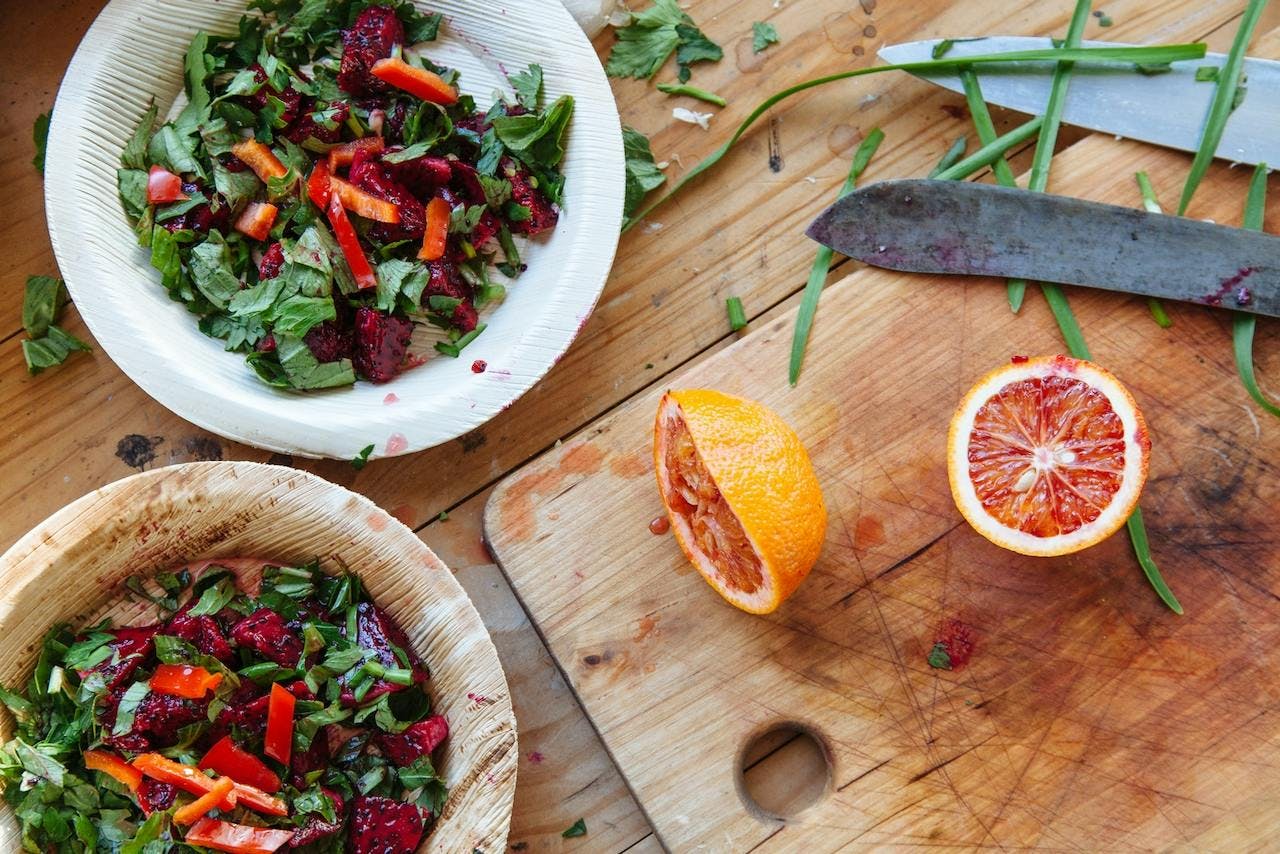One of the best ways to improve your metabolic health is through proper nutrition — and you can start by incorporating more vegetables, fruits, and “whole foods” into your diet.
Since red, green, blue, purple, yellow, and orange fruits and vegetables all have different health benefits, experts often recommend “eating the rainbow,” or consuming different colors of produce each day to ensure that you’re receiving an abundance of diverse nutrients and minerals to support your health and well-being.
Eating the rainbow: why it's important
You already know that eating fruits and vegetables is important for your overall health, but here’s a key reason why: they’re filled with phytonutrients, which are natural compounds and chemicals produced by plants [1].
Studies have shown that phytonutrients have anti-inflammatory and antioxidant properties that can help keep people healthy and reduce the risk of many diseases and cancers, and that eating 800 g/day of fruits and vegetables is associated with a decreased risk of cardiovascular disease and all-cause mortality [2]. Plant-based foods like fruits and vegetables are also generally high in polyphenols[3], the antioxidants that protect the body’s tissues against oxidative stress and inflammation.
But why eat highly pigmented foods in particular? Different phytonutrients are found in different fruits and vegetables, some coinciding with pigment. It’s important to eat a balanced diet for maximum nutritional benefit. Here are some of our favorite examples:
- Dark-green leafy vegetables contain high levels of carotenoids like lutein, which may help ward against some cancers of the epithelium (a type of body tissue that lines all the surfaces in your body) [7].
- Red, blue, and purple fruits and vegetables are especially rich in anthocyanins, which give these plants their color and also act as antioxidants [5].
- Yellow and orange produce is filled with carotenoids, which can help improve cognitive function, cardiovascular health, and eye health [6]. Some carotenoids (like lycopene) are more bioavailable (i.e., more gets absorbed) when consumed with a fat, so if you're eating a vegetable or fruit high in lycopene, add a little avocado or peanut butter or fat to help with absorption.
The benefits of green fruits and vegetables
From avocado toast to smoothies, green fruits and vegetables serve as the foundation of countless healthy meals.
High in Vitamins A and C as well as glucosinolates, carotenoids, and polyphenols, green leafy vegetables can help decrease cognitive decline, reduce cardiovascular disease, and lower blood pressure [7-10].
Green beans and pea pods have phytonutrients including carotenoids, chlorophyll, and saponins, while kiwi is incredibly high in Vitamin C [11, 12]. In one study, researchers found that participants who consumed romaine lettuce during a meal saw a dip in postprandial (post-meal) blood glucose, whereas BG increased after meals containing cellulose (fiber) and watercress [13].
So the next time you’re making dinner, don’t hesitate to scoop an extra serving of spinach or guacamole onto your plate (or snack on some romaine).
Green fruits and vegetables to add to your plate
- Kale
- Spinach
- Avocado
- Kiwi
- Romaine lettuce
- Green grapes
The benefits of red fruits and vegetables
Fruits and veggies with deeper red hues (like beets) are generally higher in phytonutrients, and research has indicated that they may also help reduce systemic inflammation and bolster the immune status by repairing cell walls and increasing the body’s production of disease-fighting cells [14].
Red bell peppers, tomatoes, and acerola cherries are high in Vitamin C, which helps improve the body’s natural immune response and destroy free radicals (an unstable and highly reactive atom or molecule that has both helpful and harmful roles in the body) [15].
In the summer, snack liberally on watermelon, which has more lycopene (an antioxidant that has been linked to lower rates of cancer, heart disease, and age-related eye diseases) than any other fresh fruit or vegetable [16].
Red fruits and vegetables to add to your plate
- Tomatoes
- Watermelon
- Beets
- Red bell peppers
- Strawberries
- Pomegranates
The benefits of blue and purple fruits and vegetables
Blue and purple produce is high in anthocyanins (a group of polyphenols that give off bluish hues).
These compounds aren’t just for looks, though: research suggests they may reduce the risk of certain cancers, Type 2 Diabetes, and obesity [17].
Blueberries and blackberries are incredibly high in antioxidants like anthocyanins, ellagic acid, and resveratrol, which neutralize harmful compounds in your body to reduce cell damage [18]. Blue tomatoes contain lycopene — which studies suggest may lead to a reduced risk of heart disease and prostate cancer — while Concord grapes may help boost the immune system [19, 20].
Blue and purple fruits and vegetables to add to your plate
- Blueberries
- Blackberries
- Plums
- Concord grapes
- Purple cabbage
- Blue tomatoes
- Eggplant
The benefits of orange and yellowfruits and vegetables
Orange and yellow produce is usually high in carotenoids (which are part of the Vitamin A family and can help benefit cardiovascular and eye health). They also tend to be high in their Vitamin A and Vitamin C count, which not only protects the body against oxidative stress (which accelerates aging and can weaken the immune system), but also acts as a lighthouse to guide neutrophils, one of your immune system’s soldiers, to areas of infection in your body [21, 22].
In addition, citrus has a flavonoid called narigenin, which studies indicate has the potential to increase glucose uptake and counteract insulin resistance induced by palmitate, a form of Vitamin A [23]. Yellow foods also often have bioflavonoid constituents which can help digestion and gut health [24].
Orange and yellow fruits and vegetables to add to your plate
- Squash
- Sweet potatoes
- Carrots
- Pumpkins
- Oranges
Key Takeaways
Eating at least five servings of fruits and vegetables a day can help lower the risks of death from heart disease, stroke, cancer, and respiratory diseases, but one in 10 adults eat the recommended amount, and as a result aren’t getting the full benefits of phytonutrients in their diet [25, 26].
Here are several simple ways to incorporate more fruits and vegetables into your routine:
- Start off the day by having a fruit smoothie or putting berries on your yogurt, chia pudding, or overnight oats.
- Instead of processed crackers or breads, which often contain high-fructose corn syrup, snack on a whole fruit with nut butter (fats help slow down the absorption of sugar by your body, maintaining stable blood glucose levels).
- Make vegetable-based soups or blend vegetables into sauces.
- Add leftover vegetables (or whatever you have in your fridge) to omelets, stir-fries, and fried rice.
- Roast vegetables to enjoy alongside your desired protein.
- Use zucchini noodles in lieu of pasta or riced cauliflower instead of white rice.
Filling up your plate with a variety of colors from fruits and vegetables is a fantastic first step to supporting your metabolic health, but it’s only one component of discovering a healthy lifestyle that supports your needs and goals.
References:
- https://www.nutrition.gov/topics/whats-food/phytonutrients
- https://academic.oup.com/ije/article/46/3/1029/3039477?login=false
- https://pubmed.ncbi.nlm.nih.gov/12109813/
- https://pubmed.ncbi.nlm.nih.gov/33641343/
- https://www.ncbi.nlm.nih.gov/pmc/articles/PMC5613902/
- https://pubmed.ncbi.nlm.nih.gov/29885291/
- https://ohioline.osu.edu/factsheet/HYG-5581
- https://pubmed.ncbi.nlm.nih.gov/29263222/
- https://journals.sagepub.com/doi/full/10.1177/2048004016661435
- https://pubmed.ncbi.nlm.nih.gov/32091599
- https://ohioline.osu.edu/factsheet/HYG-5581
- https://fdc.nal.usda.gov/fdc-app.html#/food-details/327046/nutrients
- https://lipidworld.biomedcentral.com/articles/10.1186/s12944-021-01495-9
- https://www.ncbi.nlm.nih.gov/pmc/articles/PMC7770496/
- https://www.ncbi.nlm.nih.gov/pmc/articles/PMC7770496/
- https://www.mayoclinichealthsystem.org/hometown-health/speaking-of-health/the-wonders-of-watermelon
- https://www.ncbi.nlm.nih.gov/pmc/articles/PMC5613902/
- https://pubmed.ncbi.nlm.nih.gov/12424333/
- https://pubmed.ncbi.nlm.nih.gov/12424325/
- https://pubmed.ncbi.nlm.nih.gov/19640969/
- https://www.ncbi.nlm.nih.gov/pmc/articles/PMC7770496/#B29
- https://www.ncbi.nlm.nih.gov/pmc/articles/PMC5707683/
- https://www.ncbi.nlm.nih.gov/pmc/articles/PMC6468535/
- https://www.ncbi.nlm.nih.gov/pmc/articles/PMC7770496/
- https://www.health.harvard.edu/nutrition/how-many-fruits-and-vegetables-do-we-really-need
- https://www.cdc.gov/nccdphp/dnpao/division-information/media-tools/adults-fruits-vegetables.html


